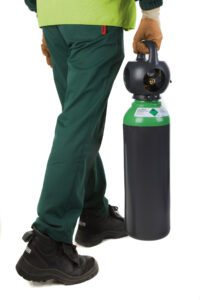A dedicated focus on preventing musculoskeletal disorders (MSDs) is driving changes that can be applied not just in the workplace, but also at home, as Christina Wolverson, Industrial Hygienist Europe at Air Products, explains…
 Musculoskeletal disorders can affect joints, tendons and muscles all over the body, developing over time and sometimes progressing from a mild niggle to severe pain. They’re a problem not only for individual workers, but also for businesses, economies and society, and are one of the most common causes of disability, sick leave and early retirement.
Musculoskeletal disorders can affect joints, tendons and muscles all over the body, developing over time and sometimes progressing from a mild niggle to severe pain. They’re a problem not only for individual workers, but also for businesses, economies and society, and are one of the most common causes of disability, sick leave and early retirement.
According to the 2015 European Working Conditions Survey, approximately three in every five workers report having an MSD, with backache and upper limb pain being the most common. In manufacturing specifically, 46 percent of workers reported backache (and MSDs in general). It is clear that more needs to be done to build greater awareness of MSDs, and encourage staff to report symptoms at the earliest stage possible, in order to help prevent further problems and future injuries.
The European Agency for Safety & Health at Work (EU-OSHA) Healthy Workplaces ‘Lighten the Load’ campaign focuses on the prevention and management of work-related MSDs. It selected 100 organisations across Europe to become its official partners – organisations that can demonstrate their commitment and achievements in tackling this issue in the workplace. Following a detailed application, Air Products is the only industrial gas company to join the European campaign to share best practice, learn from others and help to reduce and eliminate this type of work-related injury.
Many of the tasks at Air Products are manually intensive and ergonomically challenging. This work is often carried out by drivers, operators and engineers. Manual handling is therefore an area that requires regular attention. Promoting and applying the correct ergonomic principles – at home and in the workplace – plays a key part.
We’ve engaged qualified experts to support us on this journey – including physiotherapists and ergonomists. Colleagues from across the business receive practical advice from these experts through bespoke classroom training or personal discussions over the phone to address any potential problems before they get worse. Early intervention is key, with the focus ultimately on prevention rather than cure. For example, we have developed best practice guidance on how to correctly lift gas cylinders and created guidelines to help build equipment with ergonomics in mind.
Everyone learns differently

When tackling MSDs, it’s important to be as inclusive as possible – after all, it is not just those completing manual tasks that can injure themselves. With more people working from home, businesses have focussed predominantly on tackling mental health throughout the last two years, but there hasn’t been as much focus on looking after the body. We believe it’s just as important to put the emphasis not just on being safe at work but also on being safe at home. Ergonomics is for everyone, including desk-based workers (whether at home or in the workplace), so it’s vital to provide colleagues with constant education, frequent reminding, and ongoing support to help prevent injuries and ensure they finish work in the same condition they started it. For example, holding a shopping bag, tying your shoelaces, or lifting a heavy gas cylinder all require a positive and proactive approach to ergonomics.
Just as our people have to tackle different tasks dependent on their role, we appreciate that they also come from a diverse mix of ages, experiences and expertise. Everyone learns in their own way and absorbs information differently, which is why we recommend creating a mosaic of materials for colleagues, designed to tap into the different learning approaches. For example, some people may find it more comfortable to read text, whereas others prefer a more visual or animated approach to learning. At Air Products, we’re creating bespoke mini training modules for our different teams to provide micro-learning over several months – which has more effectiveness over time – and build awareness about preventing work-related MSDs through photos, videos, interactive games, presentations and best practice guides.
Our teams are also producing more video content using activities that people can easily relate to (e.g. lifting a child). Using sensor technology on people in different roles throughout the business will help us coach individuals by providing live/immediate feedback and help us verify our risk assessments. This allows us to make changes to tasks as well as change individual behaviours.
Advice on sharing MSD guidance
The key to managing and preventing work-related MSDs is using personal, subtle and shorter messaging to regularly remind everyone about the importance of using the correct posture, including when lifting lighter objects or when they’re doing familiar actions. It’s also about reminding us all that as we get older, we can’t always move in the same way we used to years ago. This bespoke, modular and interactive approach has been used in other training across the business. We’ve seen the benefits it can have, particularly when combined with a variety of different learning styles and it is about bringing advice to the forefront of the mind, in easily digestible pieces of information.
Getting the language right is crucial. Air Products is moving away from using terms such as ‘ergonomics’ or ‘manual handling’ in our internal communications, which we know can be off-putting to some people. Instead, we’re focusing on friendlier and less corporate alternatives that can help to humanise and soften our advice.
One example is our new acronym ‘GRABS’:
- Get close
- Relax posture
- Anchor position
- Big muscles,
- Spine–don’t twist – which focuses on the core principles of safe lifting and is being used in our training.
Irrespective of the number of safety initiatives in place, we’re always looking for advice and guidance from other organisations as to how we can improve. Safety is our core priority and being able to work with reputable third-party organisations like EU-OSHA provides an opportunity to share new ideas and information that can refresh and support the current programmes around safe lifting. We’ll be closely tracking future progress adjusting and adapting as necessary to ensure our colleagues are safe and protected at work, and at home.
Live webinar: Manual handling? Don’t do it until you have risk assessed! Sign up for free, now.
Safety & Health Podcast
Listen, as Matt Birtles, Principal Ergonomics Consultant at HSE’s Science and Research Centre, talks about the different approaches to managing the risks associated with Musculoskeletal disorders.
Subscribe and tune in the Safety & Health Podcast to discover the latest issues facing the health and safety profession, and stay on-top of the developments affecting your role, from working at height, lone working and common workplace hazards, to safety culture, behaviours, occupational health and mental health and wellbeing.


